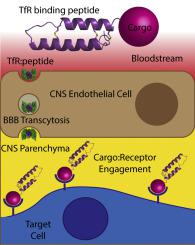Journal of Molecular Biology ( IF 4.7 ) Pub Date : 2020-04-15 , DOI: 10.1016/j.jmb.2020.04.002 Zachary R Crook 1 , Emily Girard 1 , Gregory P Sevilla 1 , Morgan Merrill 1 , Della Friend 2 , Peter B Rupert 2 , Fiona Pakiam 1 , Elizabeth Nguyen 1 , Chunfeng Yin 1 , Raymond O Ruff 1 , Gene Hopping 1 , Andrew D Strand 1 , Kathryn A K Finton 2 , Margo Coxon 1 , Andrew J Mhyre 1 , Roland K Strong 2 , James M Olson 1

|
The impenetrability of the blood–brain barrier (BBB) to most conventional drugs impedes the treatment of central nervous system (CNS) disorders. Interventions for diseases like brain cancer, neurodegeneration, or age-associated inflammatory processes require varied approaches to CNS drug delivery. Cystine-dense peptides (CDPs) have drawn recent interest as drugs or drug-delivery vehicles. Found throughout the phylogenetic tree, often in drug-like roles, their size, stability, and protein interaction capabilities make CDPs an attractive mid-size biologic scaffold to complement conventional antibody-based drugs. Here, we describe the identification, maturation, characterization, and utilization of a CDP that binds to the transferrin receptor (TfR), a native receptor and BBB transporter for the iron chaperone transferrin. We developed variants with varying binding affinities (KD as low as 216 pM), co-crystallized it with the receptor, and confirmed murine cross-reactivity. It accumulates in the mouse CNS at ~ 25% of blood levels (CNS blood content is only ~ 1%–6%) and delivers neurotensin, an otherwise non-BBB-penetrant neuropeptide, at levels capable of modulating CREB signaling in the mouse brain. Our work highlights the utility of CDPs as a diverse, easy-to-screen scaffold family worthy of inclusion in modern drug discovery strategies, demonstrated by the discovery of a candidate CNS drug delivery vehicle ready for further optimization and preclinical development.
中文翻译:

TfR 结合胱氨酸密集肽促进生物活性分子的血脑屏障渗透。
血脑屏障 (BBB) 对大多数常规药物的不可穿透性阻碍了中枢神经系统 (CNS) 疾病的治疗。对脑癌、神经变性或与年龄相关的炎症过程等疾病的干预需要不同的 CNS 药物递送方法。胱氨酸密集肽 (CDP) 作为药物或药物递送载体最近引起了人们的兴趣。在整个系统发育树中发现,通常具有类似药物的作用,它们的大小、稳定性和蛋白质相互作用能力使 CDP 成为一种有吸引力的中型生物支架,以补充传统的基于抗体的药物。在这里,我们描述了与转铁蛋白受体 (TfR)、铁伴侣转铁蛋白的天然受体和 BBB 转运蛋白结合的 CDP 的识别、成熟、表征和利用。K D低至 216 pM),将其与受体共结晶,并证实了鼠交叉反应性。它以约 25% 的血液水平在小鼠 CNS 中积聚(CNS 血液含量仅为约 1%–6%),并以能够调节小鼠大脑中 CREB 信号传导的水平提供神经降压素,否则是一种非 BBB 穿透性神经肽. 我们的工作强调了 CDP 作为一个多样化、易于筛选的支架家族的实用性,值得纳入现代药物发现策略,这一点通过发现一种可供进一步优化和临床前开发的候选 CNS 药物递送载体来证明。











































 京公网安备 11010802027423号
京公网安备 11010802027423号